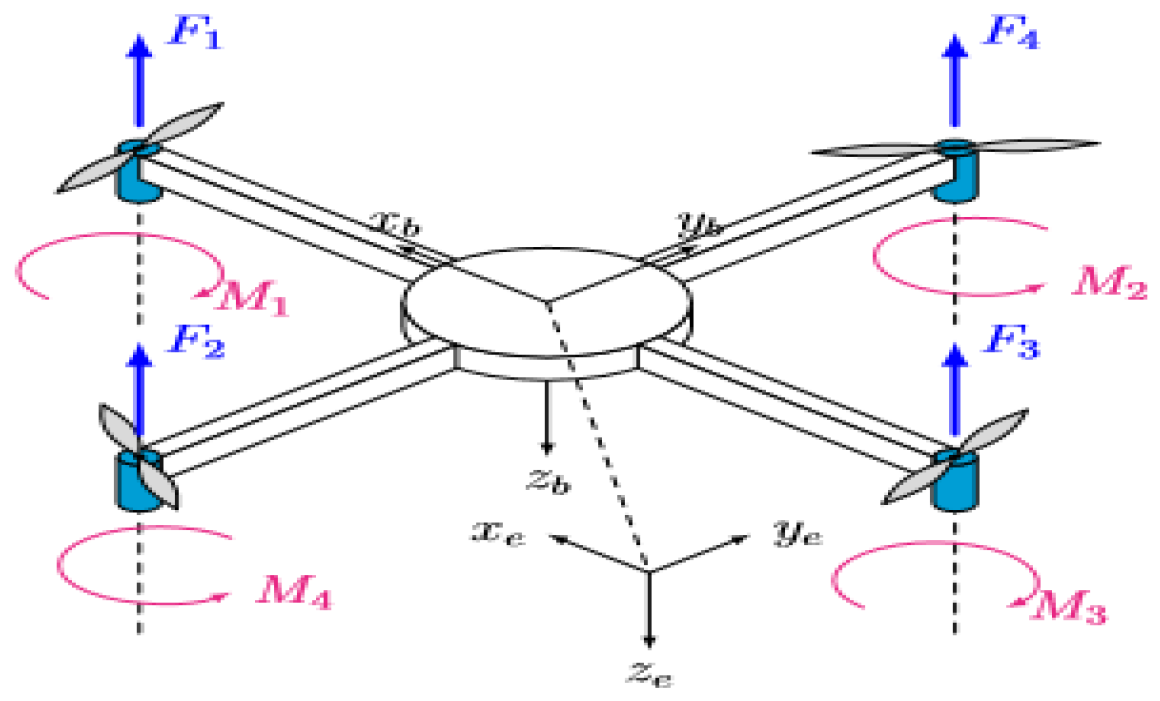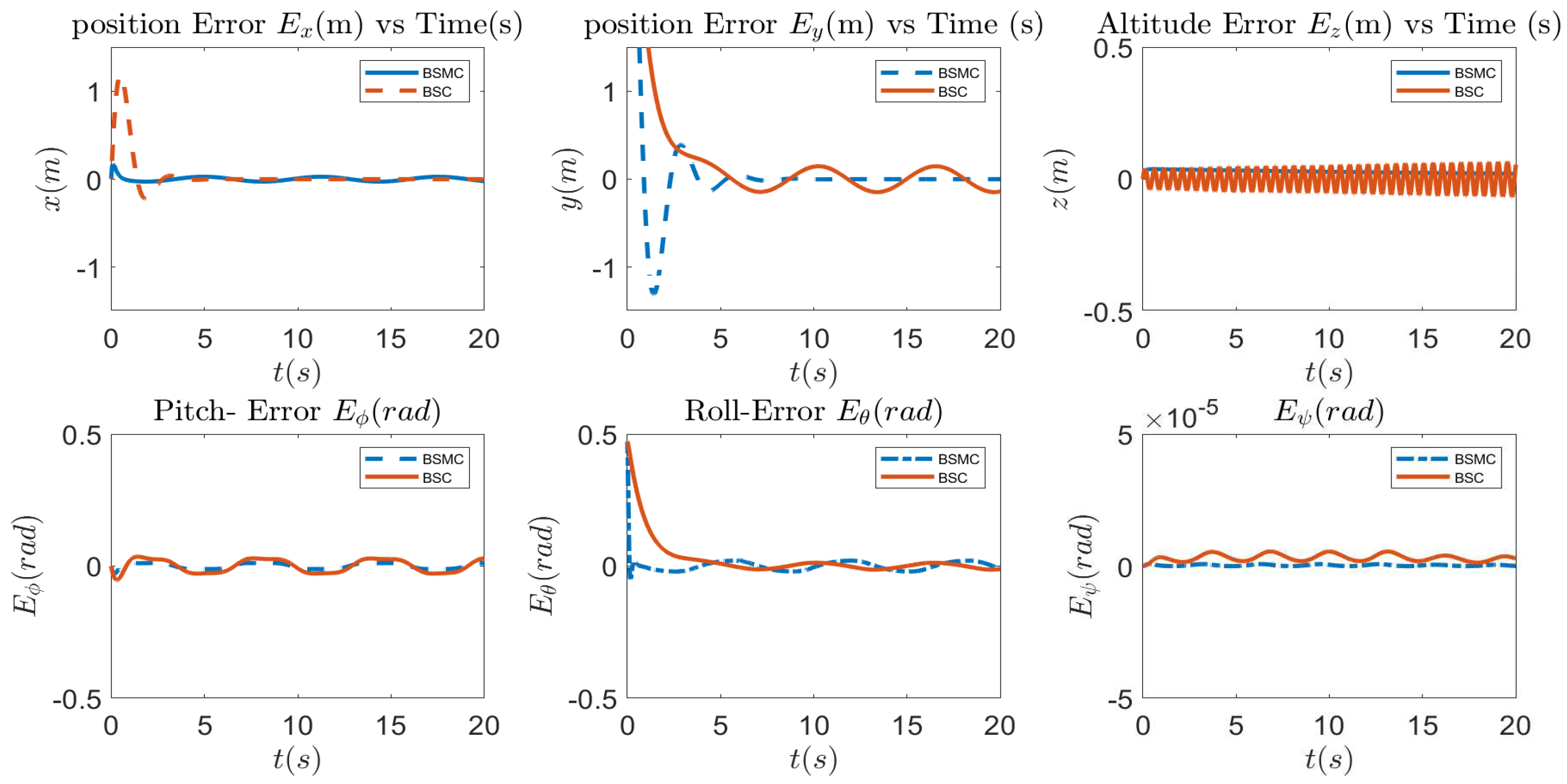Robust Backstepping Sliding Mode Control for a Morphing Quadcopter UAV †
Abstract
1. Introduction
1.1. Background
1.2. Related Works
1.3. Paper Organization
2. System Modelling
2.1. System Description
2.2. Model Assumptions
- The central body is assumed to be a rigid square cuboid hosting the battery and other avionics components, rotating arms are assumed to be rectangular rod, the servomotor is assumed to be rectangular cuboid and the motors (rotors) are assumed to be cylindrical.
- The morphing quadcopter is comprising of a finite number of objects called components, each of which has constant density.
- The centre of gravity and the body frame origin coincide.
- The thrust and drag forces are proportional to the square of propeller’s speed.
2.3. System Modelling
3. Control Synthesis
3.1. State Space Formulation
3.2. Control Structure
3.3. Backstepping Sliding Mode Control (BSMC)
4. Results and Discussion
4.1. Servo Arm Control
4.2. Position and Orientation Control
4.3. Performance Evaluation
4.4. Results Interpretations
5. Conclusions
Future Work
Author Contributions
Funding
Informed Consent Statement
Conflicts of Interest
References
- Shehu, I.A.; Mohammed, M.; Sulaiman, S.H.; Abdulkarim, A.; Alhassan, A.B. A Review on Unmanned Aerial Vehicle Energy Sources and Management. In International Conference on Emerging Applications and Technologies for Industry 4.0 (EATI’2020); Abawajy, J.H., Choo, K.K.R., Chiroma, H., Eds.; Lecture Notes in Networks and Systems; Springer: Cham, Switzerland, 2021; Volume 254. [Google Scholar] [CrossRef]
- Tothong, T.; Samawi, J.; Govalkar, A.; George, K. Morphing Quadcopters: A Comparison Between Proposed and Prominent Foldable Quadcopters. In Proceedings of the 2020 11th IEEE Annual Information Technology, Electronics and Mobile Communication Conference (IEMCON), Vancouver, BC, Canada, 4–7 November 2020; pp. 0589–0596. [Google Scholar]
- Hoffmann, K.A.; Chen, T.G.; Cutkosky, M.R.; Lentink, D. Bird-inspired robotics principles as a framework for developing smart aerospace materials. J. Compos. Mater. 2023, 57, 679–710. [Google Scholar] [CrossRef]
- Floreano, D.; Mintchev, S.; Shintake, J. Foldable drones: From biology to technology. Bioinspir. Biomimetics Bioreplication 2017, 10162, 1016203. [Google Scholar]
- Falanga, D.; Kleber, K.; Mintchev, S.; Floreano, D.; Scaramuzza, D. The foldable drone: A morphing quadrotor that can squeeze and fly. IEEE Robot. Autom. Lett. 2018, 4, 209–216. [Google Scholar] [CrossRef]
- Belmouhoub, A.; Bouzid, Y.; Medjmadj, S.; Hocine Derrouaoui, S.; Guiatni, M. Backstepping control merged with disturbances observer for quadrotor with rotating arms. J. Unmanned Syst. 2024, 12, 61–74. [Google Scholar] [CrossRef]
- Derrouaoui, S.H.; Bouzid, Y.; Guiatni, M. Nonlinear robust control of a new reconfigurable unmanned aerial vehicle. Robotics 2021, 10, 76. [Google Scholar] [CrossRef]
- Bucki, N.; Mueller, M.W. Design and control of a passively morphing quadcopter. In Proceedings of the 2019 International Conference on Robotics and Automation (ICRA), Montreal, QC, Canada, 20–24 May 2019; pp. 9116–9122. [Google Scholar]
- Nemati, A. Designing, Modeling and Control of a Tilting Rotor Quadcopter. Doctoral Dissertation, University of Cincinnati, Cincinnati, OH, USA, 2016. [Google Scholar]
- Riviere, V.; Manecy, A.; Viollet, S. Agile robotic fliers: A morphing-based approach. Soft Robot. 2018, 5, 541–553. [Google Scholar] [CrossRef] [PubMed]
- Zhao, N.; Luo, Y.; Deng, H.; Shen, Y. The deformable quad-rotor: Design, kinematics and dynamics characterization, and flight performance validation. In Proceedings of the 2017 IEEE/RSJ International Conference on Intelligent Robots and Systems (IROS), Vancouver, BC, Canada, 24–28 September 2017; pp. 2391–2396. [Google Scholar]
- Desbiez, A.; Expert, F.; Boyron, M.; Diperi, J.; Viollet, S.; Ruffier, F. X-Morf: A crash-separable quadrotor that morfs its X-geometry in flight. In Proceedings of the 2017 Workshop on Research, Education and Development of Unmanned Aerial Systems (RED-UAS), Linköping, Sweden, 3–5 October 2017; pp. 222–227. [Google Scholar]
- Brown, L.; Clarke, R.; Akbari, A.; Bhandari, U.; Bernardini, S.; Chhabra, P.; Marjanovic, O.; Richardson, T.; Watson, S. The design of prometheus: A reconfigurable uav for subterranean mine inspection. Robotics 2020, 9, 95. [Google Scholar] [CrossRef]
- Papadimitriou, A.; Mansouri, S.S.; Kanellakis, C.; Nikolakopoulos, G. Geometry aware nmpc scheme for morphing quadrotor navigation in restricted entrances. arXiv 2021, arXiv:2101.02965. [Google Scholar]
- Wallace, D.A. Dynamics and Control of a Quadrotor with Active Geometric Morphing. Master’s Thesis, University of Washington, Washington, DC, USA, 2016. Available online: http://hdl.handle.net/1773/35518 (accessed on 1 January 2025).
- Derrouaoui, S.H.; Bouzid, Y.; Belmouhoub, A.; Guiatni, M. Enhanced nonlinear adaptive control of a novel over-actuated reconfigurable quadcopter. In Proceedings of the 2023 International Conference on Unmanned Aircraft Systems (ICUAS), Warsaw, Poland, 6–9 June 2023; pp. 229–234. [Google Scholar]
- Ryll, M.; Bülthoff, H.H.; Giordano, P.R. First flight tests for a quadrotor UAV with tilting propellers. In Proceedings of the 2013 IEEE International Conference on Robotics and Automation, Karlsruhe, Germany, 6–10 May 2013; pp. 295–302. [Google Scholar]
- Hintz, C.; Torno, C.; Carrillo, L.R.G. Design and dynamic modeling of a rotary wing aircraft with morphing capabilities. In Proceedings of the 2014 International Conference on Unmanned Aircraft Systems (ICUAS), Orlando, FL, USA, 27–30 May 2014; pp. 492–498. [Google Scholar]
- Zhao, M.; Anzai, T.; Shi, F.; Chen, X.; Okada, K.; Inaba, M. Design, modeling, and control of an aerial robot dragon: A dual-rotor-embedded multilink robot with the ability of multi-degree-of-freedom aerial transformation. IEEE Robot. Autom. Lett. 2018, 3, 1176–1183. [Google Scholar] [CrossRef]
- Belmouhoub, A.; Medjmadj, S.; Bouzid, Y.; Derrouaoui, S.H.; Guiatni, M. Enhanced backstepping control for an unconventional quadrotor under external disturbances. Aeronaut. J. 2023, 127, 627–650. [Google Scholar] [CrossRef]
- Derrouaoui, S.H.; Bouzid, Y.; Guiatni, M. PSO based optimal gain scheduling backstepping flight controller design for a transformable quadrotor. J. Intell. Robot. Syst. 2021, 102, 67. [Google Scholar] [CrossRef]
- Darvishpoor, S.; Roshanian, J.; Raissi, A.; Hassanalian, M. Configurations, flight mechanisms, and applications of unmanned aerial systems: A review. Prog. Aerosp. Sci. 2020, 121, 100694. [Google Scholar] [CrossRef]






| S/N | Configuration | ||||
|---|---|---|---|---|---|
| 1 | X | ||||
| 2 | 0 | 0 | H | ||
| 3 | 0 | Y | |||
| 4 | 0 | 0 | T | ||
| 5 | O |
Disclaimer/Publisher’s Note: The statements, opinions and data contained in all publications are solely those of the individual author(s) and contributor(s) and not of MDPI and/or the editor(s). MDPI and/or the editor(s) disclaim responsibility for any injury to people or property resulting from any ideas, methods, instructions or products referred to in the content. |
© 2025 by the authors. Licensee MDPI, Basel, Switzerland. This article is an open access article distributed under the terms and conditions of the Creative Commons Attribution (CC BY) license (https://creativecommons.org/licenses/by/4.0/).
Share and Cite
Shehu, I.A.; Haruna, Z.; Mu’azu, M.B.; Abdurrazaq, M.B.; Abdulwahab, N.B.; Umar, A. Robust Backstepping Sliding Mode Control for a Morphing Quadcopter UAV. Eng. Proc. 2025, 87, 86. https://doi.org/10.3390/engproc2025087086
Shehu IA, Haruna Z, Mu’azu MB, Abdurrazaq MB, Abdulwahab NB, Umar A. Robust Backstepping Sliding Mode Control for a Morphing Quadcopter UAV. Engineering Proceedings. 2025; 87(1):86. https://doi.org/10.3390/engproc2025087086
Chicago/Turabian StyleShehu, Ibrahim Abdullahi, Zaharuddeen Haruna, Muhammad Bashir Mu’azu, Muhammad Bashir Abdurrazaq, Norhaliza Bint Abdulwahab, and Abubakar Umar. 2025. "Robust Backstepping Sliding Mode Control for a Morphing Quadcopter UAV" Engineering Proceedings 87, no. 1: 86. https://doi.org/10.3390/engproc2025087086
APA StyleShehu, I. A., Haruna, Z., Mu’azu, M. B., Abdurrazaq, M. B., Abdulwahab, N. B., & Umar, A. (2025). Robust Backstepping Sliding Mode Control for a Morphing Quadcopter UAV. Engineering Proceedings, 87(1), 86. https://doi.org/10.3390/engproc2025087086







